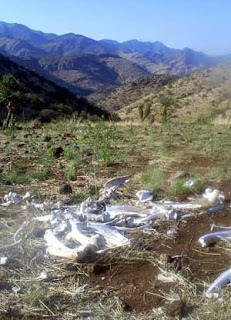What is now happening is not an invasion of Mexico but an invasion of the drug industry people that Mexico is unable to control. What is a tragedy is that American citizens are caught in the middle of this and their rights to "Life, Liberty and the pursuit of Happiness" are being trampled on by a criminal element. The other part of that tragedy is that the very government brought about by the greatest Constitution every written has wandered so far from the intent of that document as to be powerless to stop this travesty of justice.
Remember Ignacio Ramos and Jose Campeon? Here is their story from the news article: "These are Border Patrol agents who, in an incident near Fabens, Texas, in 2005, shot a fleeing drug-smuggler in the butt and wound up going to jail for 11 and 12 years, respectively. The U.S. attorney gave the drug-runner immunity to testify against the agents.
When it comes to the law versus the smugglers, the message that sends is crystal-clear. It's also difficult to reach any other conclusion when you hear a federal judge rule that illegal aliens have a right to interstate travel, as John Roll did in March, in a civil-rights case involving high-profile rancher Roger Barnett, a corridor resident. "
We have a serious crisis along the border and it does not even register on our national news....
If you want to see some of the most rugged of mountain ranges and areas and at the same time some of the most beautiful, use Google Earth and the areas named in this news article to locate them......this is all being ruined because we won't allow our enforcement agencies to do their jobs.
PUBLISHED ON SEPTEMBER 11, 2008:
The Chiricahua Corridor
Drug-trafficking and crime victimize residents and destroy the environment along the Southern Arizona-New Mexico border
By LEO W. BANKS
Leo W. Banks
These peaks above Portal are called Twin Peaks. The illegal alien trail goes along Horseshoe Saddle and drops to the base of the peaks into South Fork.
These peaks above Portal are called Twin Peaks. The illegal alien trail goes along Horseshoe Saddle and drops to the base of the peaks into South Fork.
Leo W. Banks
The remains of a dead cow at Jackwood Pass, high in the Chiricahuas. Illegal aliens walk over the mountains in the background.
The remains of a dead cow at Jackwood Pass, high in the Chiricahuas. Illegal aliens walk over the mountains in the background.
Leo W. Banks
Medications and supplements used by illegal aliens in the Chiricahua Corridor.
Medications and supplements used by illegal aliens in the Chiricahua Corridor.
Leo W. Banks
An illegal alien camp at Burro Springs in the Chiricahua Mountains.
An illegal alien camp at Burro Springs in the Chiricahua Mountains.
Leo W. Banks
Part of the illegal dumpsite at Burro Springs in the Chiricahuas.
Part of the illegal dumpsite at Burro Springs in the Chiricahuas.
The roar of an ATV is hard to miss at 3 a.m. on a dark night in the Chiricahua Mountains. The sound carries a mighty distance, ricocheting through the canyons--and to anyone living in that place, in these times, it's recognized immediately as the sound of trouble.
So it was the night of July 16, when an ATV, almost certainly loaded with drugs, rumbled north across the Mexican border. It likely crossed the line on the west end of the San Bernardino National Wildlife Refuge, east of Douglas, came north along Black Draw through the heart of the San Bernardino Valley, then swung west across State Highway 80 into the Pedregosa Mountains.
From there, the smuggler bulled his way north through draws and washes up to Rucker Canyon on the west side of the Chiricahuas, possibly as far as Turkey Creek. It was a mad dash for sure, and the best evidence indicates he rode the entire distance, as much as 40 miles, in a single night, his wheels turned backward to foil trackers.
Residents view the ATV incursion, the first of several, as an escalation in an already intense battle with smugglers working the so-called Chiricahua Corridor. Perhaps optimistically, some view this pathway through southeast Arizona as one of the last wide-open border smuggling routes, and they fear the traffickers will grow more desperate as they fight to keep it open.
Already, residents have had to make room in their lives for everything the traffickers bring with them--suspicion, constant watchfulness, vandalism and break-ins. As a matter of course, few people dare leave their homes without a sitter. Alex Stone, a helicopter specialist for the Forest Service who owns a house near Portal, on the east side of the Chiricahuas, says flatly, "If you leave your house empty, it will be occupied."
Law enforcement? Border Patrol might be an hour away on a good day, and on a bad day, residents have to fend for themselves when the agency dispatcher in Douglas says, as sometimes happens, "Sorry, we have nobody to send."
The traffic has also brought to the Chiricahua Mountains, one of Arizona's special places, the same ugliness we see in other sanctuaries closer to the border: Piles of trash now foul major canyons and waters in the northeastern part of the range. Erosion bedevils established hiking trails, and illegals are making new trails in areas as high as 9,000 feet.
What's happening in the corridor challenges the government's campaign of using this year's decrease in arrests, nearing 25 percent in some areas, to convince citizens they're finally getting the border under control. It also shows the relentless northward march of the smugglers. After all, those who cross the Chiricahuas and walk all the way to Interstate 10, at the northern end of the corridor, have trekked nearly 70 punishing miles--evading law enforcement--putting them deep into the United States.
PLEASE read the rest of the story of the Chiricahua Corridor






No comments:
Post a Comment